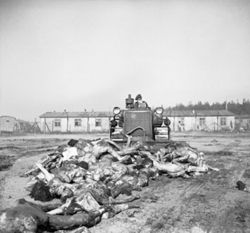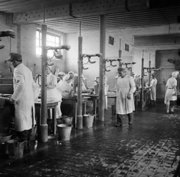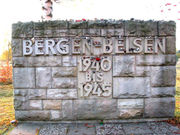Bergen-Belsen concentration camp
2008/9 Schools Wikipedia Selection. Related subjects: World War II
Bergen-Belsen (or Belsen) was a Nazi concentration camp in Lower Saxony, southwest of the town of Bergen near Celle. Between 1943 and 1945, an estimated 50,000 people died there, up to 35,000 of them dying of typhus in the first few months of 1945.
The camp was liberated on April 15, 1945 by the British 11th Armoured Division. Sixty thousand prisoners were found inside, most of them seriously ill, and another 13,000 corpses lay around the camp unburied. The scenes that greeted British troops were famously described by the BBC's Richard Dimbleby, who accompanied them:
| “ | Here over an acre of ground lay dead and dying people. You could not see which was which ... The living lay with their heads against the corpses and around them moved the awful, ghostly procession of emaciated, aimless people, with nothing to do and with no hope of life, unable to move out of your way, unable to look at the terrible sights around them ... Babies had been born here, tiny wizened things that could not live ... A mother, driven mad, screamed at a British sentry to give her milk for her child, and thrust the tiny mite into his arms, then ran off, crying terribly. He opened the bundle and found the baby had been dead for days. This day at Belsen was the most horrible of my life. |
” |
Operation
Bergen-Belsen was first set up in 1940 as the prisoner of war camp Stalag XI-C (named Stalag XI-C/311 for 600 Belgian and French POW's). Between this time and the spring of 1942, about 18,000 Soviet soldiers died of hunger, cold and disease.
In 1942, Bergen-Belsen became a concentration camp and was placed under SS command in April 1943. Initially it was designated Aufenthaltslager ("detention camp") to hold several thousand Jews intended to be sent overseas in exchange for German civilians who were interned. In March 1944, part of the camp was redesignated as an Erholungslager ("recovery camp"), where prisoners too sick to work were brought from other camps. In August 1944, a shipment of approximately 8,000 female prisoners of various nationalities arrived from Auschwitz, most of whom were sent to Arbeitskommandos to work in factories.
December 1944 saw the completion of the change-over of Bergen-Belsen into a concentration camp when SS- Hauptsturmführer Josef Kramer, previously at Auschwitz-Birkenau, became the new camp commander. The number of inmates in the camp on December 1, 1944, was 15,257. In 1945, large numbers of prisoners were moved to Belsen from the eastern camps as the Soviet forces advanced. The resulting overcrowding led to a vast increase in deaths from disease (particularly typhus) and malnutrition in a camp originally designed to hold about 10,000 inmates. The number of inmates increased from 22,000 on February 1, 1945, to 41,520 on March 1, 43,042 on April 1 and ultimately to about 60,000 on April 15. The number of deaths increased from 7,000 in February to 18,168 during March and 9,000 during the first half of April. The bodies of these prisoners were buried in mass graves.
There were no gas chambers in Bergen-Belsen, since the mass executions took place in the camps further east. Nevertheless, an estimated 50,000 Jews, Czechs, Poles, anti-Nazi Christians, homosexuals, and Roma and Sinti (Gypsies) died in the camp. Among them were Czech painter and writer Josef Čapek (est. April 1945), as well as Amsterdam residents Anne Frank (who died of typhus) and her sister Margot, who died there in March 1945. The average life expectancy of an inmate was nine months.
After the war, there were allegations that the camp (or possibly a section of it), was "of a privileged nature", compared to others. A lawsuit filed by the Jewish community in Thessaloniki against 55 alleged collaborators claims that 53 of them were sent to Bergen-Belsen "as a special favour" granted by the Germans.
Liberation
When the British and Canadians advanced near the camp in 1945, the German army negotiated an exclusion zone around it to prevent the spread of typhus. Hungarian and regular German troops guarding the camp returned to German lines after the engagement. Some SS guards also fled the camp; however, a number remained, wearing white armbands as a sign of surrender. As a final act of defiance, the last of the Germans to leave cut the water supply to the camp, making it hard for the Allied troops to treat the ill prisoners. On the 13th day after liberation, the Luftwaffe bombed one of the hospitals where the sick were being treated, injuring or killing several Red Cross workers.
When British and Canadian troops liberated the camp on April 15, 1945, they found thousands of bodies unburied and forced the remaining SS personnel to bury them. Over the next days the surviving prisoners were deloused and moved to a nearby German Panzer army camp, which became the Bergen-Belsen DP camp. Bergen-Belsen concentration camp was then burned to the ground by vehicle-mounted flamethrowers because of a typhus epidemic and louse infestation. Accounts of Belsen after this time refer to events at the Bergen-Belsen DP camp.
In spite of massive efforts to help the survivors, about another 9,000 died in April, and by the end of June 1945 another 4,000 had died (after liberation a total of 13,994 people died). The total number of deaths at Bergen-Belsen from 1943 to June 1945 was about 50,000.
The British troops and medical staff tried these diets to feed the prisoners, in this order:
- Bully beef from Army rations. Most of the prisoners' digestive systems were in too weak a state from long-term starvation to handle such food, and their stomachs rejected it with vomiting and diarrhea.
- Skimmed milk. The result was a bit better, but still far from acceptable.
- Bengal Famine Mixture. This is a rice-and-sugar-based mixture which had achieved good results after the Bengal famine of 1943, but it proved less suitable to Europeans than to Bengalis because of the differences in the food to which they were accustomed. Adding paprika to it proved to make it easier for the prisoners to digest, and recovery started.
Aftermath

Many of the former SS staff that survived the typhus epidemic were tried by the British at the Belsen Trial. At the trial, the world got its first view of Irma Grese, Elisabeth Volkenrath, Juana Bormann, Fritz Klein, Josef Kramer, and the rest of the SS men and women who before served at Mittelbau Dora, Ravensbrück, Auschwitz I, II, III, and Neuengamme. Many of the female guards had served at small Gross Rosen subcamps at Neusalz, Langenleuba, and the Mittelbau-Dora subcamp at Gross Werther.
The site is open to the public, featuring a visitors' centre, a monument to the dead, and a "House of Silence" for reflection.
On April 15, 2005 there was a commemorative ceremony, and many ex-prisoners and ex-liberating troops attended.
Personal accounts
- Michael Bentine wrote this on his encounter with Belsen:
- We were headed for an airstrip outside Celle, a small town, just north of Hanover. We had barely cranked to a halt and started to set up the ‘ops’ tent, when the Typhoons thundered into the circuit and broke formation for their approach. As they landed on the hastily repaired strip – a ‘Jock’ doctor raced up to us in his jeep.
- ‘Got any medical orderlies?’ he shouted above the roar of the aircraft engines. ‘Any K rations or vitaminised chocolate?’
- ‘What’s up?’ I asked for I could see his face was grey with shock.
- ‘Concentration camp up the road,’ he said shakily, lighting a cigarette. ‘It’s dreadful – just dreadful.’ He threw the cigarette away untouched. ‘I’ve never seen anything so awful in my life. You just won’t believe it till you see it – for God’s sake come and help them!’
- ‘What’s it called?’ I asked, reaching for the operations map to mark the concentration camp safely out of the danger area near the bomb line.
- ‘Belsen,’ he said, simply.
- Millions of words have been written about these horror camps, many of them by inmates of those unbelievable places. I’ve tried, without success, to describe it from my own point of view, but the words won’t come. To me Belsen was the ultimate blasphemy.
- After VE. Day I flew up to Denmark with Kelly, a West Indian pilot who was a close friend. As we climbed over Belsen, we saw the flame-throwing Bren carriers trundling through the camp – burning it to the ground. Our light Bf 108 rocked in the superheated air, as we sped above the curling smoke, and Kelly had the last words on it.
- ‘Thank Christ for that,’ he said, fervently.
- And his words sounded like a benediction.
- Banksy's manifesto consists of an account of Mervin Willett Gonin DSO of the immediate aftermath to the liberation of Bergen-Belsen. Gonin's diary extract is sourced to the Imperial War Museum.
- Leonard Webb, British veteran from the liberation of the camp.




